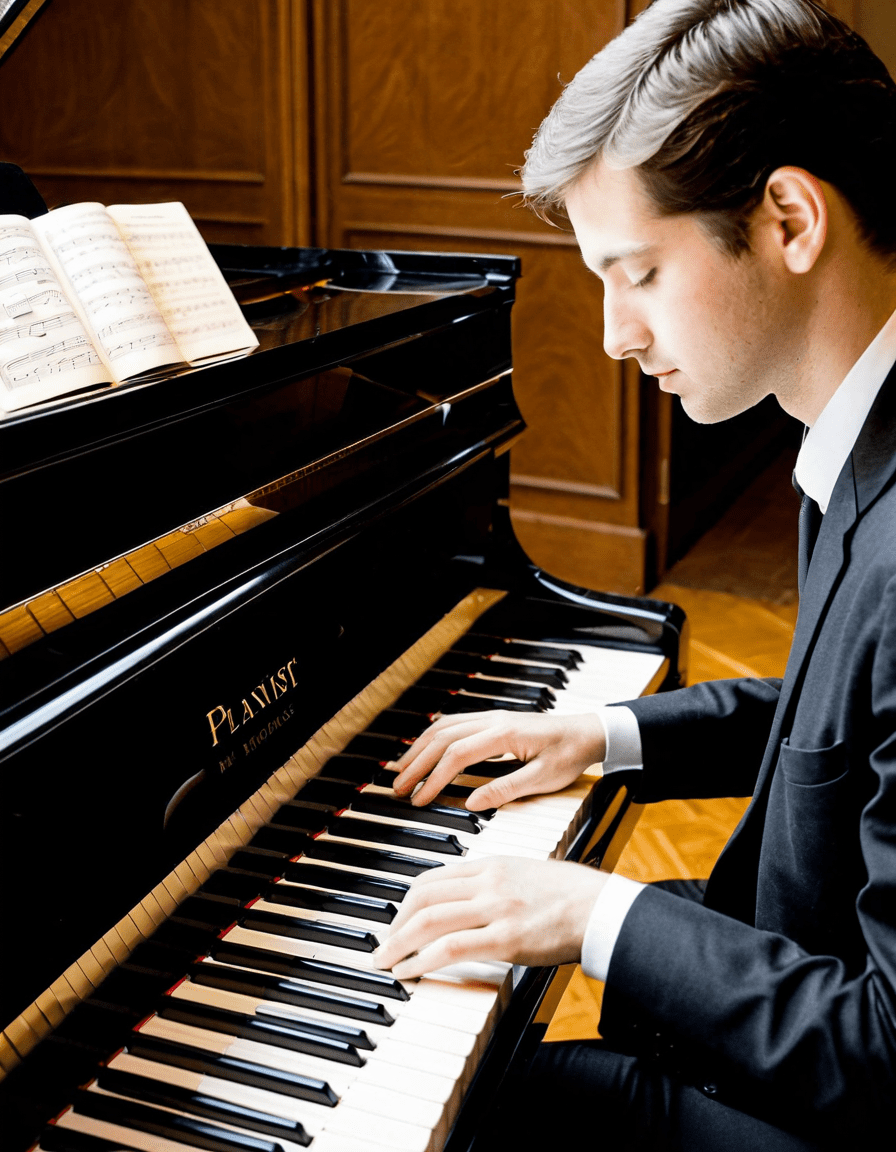In cinema, stories often resonate through the language of pain and triumph. The Pianist, directed by Roman Polanski, offers a stunning portrayal of resilience through music amidst the horrors of war. The film, while anchored in tragedy, encapsulates the transformative power that music holds—a theme that reverberates not only through the film’s narrative but also throughout the lives of countless pianists who have channeled their own struggles into art. Pain turns into melody; that’s not just a notion; it’s the essence of what makes music profoundly human. In this piece, we will explore the pianist’s journey from despair to mastery, highlighting how personal hardships can fuel artistic expression.

The Pianist’s Journey: From Despair to Mastery
1. The Descent into Darkness
Great music often arises from the depths of human sorrow. Just think about Ludwig van Beethoven. His late works, particularly the haunting Moonlight Sonata, reflect his transition through deafness and despair. Instead of allowing his condition to quash his creative spirit, Beethoven turned his silence into some of the most impactful music in history. Fast forward to the 20th century, where jazz icon Bill Evans faced his own battles with substance abuse. Evans’s emotionally charged pieces resonate with listeners, making his improvisational style a reflection of personal loss and unexpressed anguish.
The connection between personal pain and musical creation is as old as music itself. For example, contemporary sensations like Yiruma, known for the ethereal “River Flows in You,” draw upon memories of love and separation. The pianist isn’t just hitting keys; they’re conveying a tapestry of emotions that listeners can deeply relate to—each note a testimony to survival and triumph.
2. Exploring “The Longest Yard”: The Transformational Power of Music
When thinking about the longest yard, we can interpret it as the emotional journey from hardship to healing—each key pressed represents a step forward. Legendary pianist Horace Parlan, who struggled with polio, indeed illustrates this well. His unique touch on the piano stemmed from overcoming physical limitations and crafting sound from resilience. Parlan remarked that every note he played was akin to his journey, transforming adversity into a form of beauty.
The correlation of struggle with musical expression isn’t just a one-off situation. Many artists throughout history reflect the transformative power of music. For instance, legends like Clara Schumann navigated personal tragedies—such as the untimely death of her husband—by pouring her sorrow into deeply emotive compositions. The physical act of playing the piano became a sanctuary, aiding in the healing process and bridging the gap from personal sorrow to public expression, making her one of the most celebrated figures in classical music.
3. Reflections on “The Departed”: The Role of Memory in Musical Composition
Memory is an undercurrent in musical composition, lending a deeper understanding of how pain transforms into expression. Frédéric Chopin’s lost loves and nostalgic sentiments are intricately weaved into works like the Nocturne in C-sharp minor, which evokes profound feelings of longing and melancholy. His ability to tap into personal memories and articulate them through his music showcases how memory shapes the emotional landscape of any pianist’s performance.
Similarly, when Yiruma plays, each note seems to embody fleeting moments, bringing forth memories layered in complexity and emotion. Listeners are taken on a reflective journey that intertwines their own memories of love and loss. This ability to connect is what elevates the work of the pianist to something more universal—a shared human experience that echoes across generations.

The Matrix of Emotions: Complex Layers in Pianistic Expression
Speaking of complexities, the intricacies of human emotion, much like The Matrix, present multiple realities and experiences all at once. Pianists like Lang Lang master this phenomenon, seamlessly blending joy and sorrow. Every performance showcases an array of emotions where listeners feel every pulsating beat—the high and lows creating a harmonic experience that transcends the ordinary.
Another notable figure is Keith Jarrett, whose Köln Concert remains an auditory masterpiece. Jarrett’s improvisational genius reflects a personal narrative intertwined with collective experiences, epitomizing the concept of emotional alchemy in music. Just as in film where complex narratives merge to create a compelling storyline, the layers of emotion in Jarrett’s performance invite audiences into an intimate space where they can share their feelings of pain and joy simultaneously.
The Alchemy of Pain: The Pianist as Emotional Conduit
The shared experiences of pianists demonstrate how pain can act as a conduit for profound artistic expression. Historically, artists like Clara Schumann and contemporary figures like the pianist Yiruma seamlessly transformed personal suffering into compositions that resonate with audiences on deep emotional levels. The raw energy and improvisational flair exhibited by musicians like Keith Jarrett further exemplify the ability to shape sorrow into a collective experience of beauty.
In every note and phrase, the stories unfold—where pain isn’t merely endured but is metamorphosed into something incredibly beautiful. Each performance tells a story; it illuminates the path from anguish to triumph and human connection.
The Unending Dialogue: Pain and Creation in the Life of a Pianist
The conversation between creativity and personal pain is timeless and spans generations of musicians. Whether overwhelmed by despair or inspired by resilience, the pianist’s journey continues to echo truths about the human experience. By sharing their narratives through music, these musicians not only elevate their artistry but create a bond with audiences. This ongoing dialogue invites the next generation of pianists to plunge into their own depths and sculpt experiences into compositions filled with rich emotional complexity.
In conclusion, the pianist exemplifies the journey of transforming pain into melody, creating a resonant tapestry that connects us through shared hardships and triumphs. From the struggles of Beethoven and Chopin to the improvisations of Jarrett and Lang Lang, we’re reminded of the strength that lies within every key pressed. Music, in its essence, becomes a universal language—a testament to the resilience of the human spirit in the face of adversity. Just like in the film The Pianist, where the protagonist channels every ounce of suffering into the beauty of music, every pianist continues to inspire and elevate the human experience through their art.
The Pianist and the Symphony of Survival
The Inspiration Behind the Music
When you think about the challenges faced by the pianist, it’s hard not to appreciate the deep emotional journey that fuels the music. This film isn’t just about musical talent; it’s also a poignant reminder of human resilience. Did you know that the film’s leading actor drew inspiration from real experiences? This brings to mind the raw performances seen in shows like Matt Czuchry ’ s Shows, where actors pull deep from their emotional wells. Like a skilled artist, the pianist transforms despair into haunting melodies that genuinely resonate, creating a narrative that’s as engaging as the latest gop debate.
Life as a Struggle and a Triumph
The journey through traumatic experiences can often be a pathway to artistic greatness. It’s fascinating to note that the pianist navigates through themes of loss and survival, just as countless musicians have before him. Speaking of journeys, think about the labor and grit it takes to build a body like a t bar row🙁 both are about pushing through hardships to create something beautiful and impactful. Similarly, the pianist’s struggles culminate in a triumphant performance that leaves audiences in awe, echoing sentiments felt by fans of shows like The Terminal list, where every character faces challenges head-on.
Music as Healing
The way musicians transform their suffering into art is indicative of a deeper truth about the human experience. This transformation is akin to the evolution found in the life of a rocker, who takes personal trials and reshapes them into powerful anthems. This theme is also prevalent in films like the pianist, demonstrating that creativity often blooms from pain and hardship. One can’t help but draw parallels with works that explore solitude, like the concept of an archipelago, where isolation often breeds profound reflections. As the pianist illustrates, loneliness entwined with music can lead to a cathartic experience that heals both artist and audience alike.
So, whether you’re diving into the world of the pianist, exploring the culinary aspects of qué es avena while enjoying a quiet moment, or dreaming of escape to beautiful places like tasmania, keep in mind how art transcends barriers and turns life’s struggles into enriching narratives that connect us all. Each note played in the pianist stands as a testament to the power of resilience through artistic expression, reminding us that even in our darkest moments, beauty can thrive.





